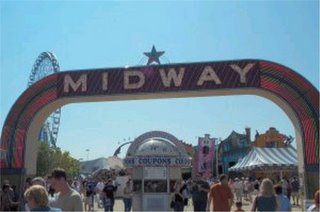Living for the City
I grew up mostly in northern Illinois, and though it wasn't a racial Mecca, the bigotry wasn't as blatant and official as it was in Texas. My brother, sister and I were relative innocents. Not long after our arrival we took a city bus to downtown Dallas to see a movie. We piled into the bus and raced for the back seats, where kids could goof off far from the driver's attention. We didn't know that the back of the bus was reserved for African Americans. Our cousins sat in front and pretended they didn't know us. They had learned the rules quickly. We stayed in the back. We didn't care. The back was more fun, and the company was better.
 One night we went to the "Midway," the amusement park where the Texas State Fair is held, located next to the Cotton Bowl. The most popular attraction was the dunk tank, where you could throw baseballs at a target to knock a person on a perched chair into the water. They had two tanks to accommodate the lines of eager throwers.
One night we went to the "Midway," the amusement park where the Texas State Fair is held, located next to the Cotton Bowl. The most popular attraction was the dunk tank, where you could throw baseballs at a target to knock a person on a perched chair into the water. They had two tanks to accommodate the lines of eager throwers.Why, one might ask, was this attraction so popular? Surprise, surprise, the guys in the tanks were black. White guy after white guy would try his skill and fail. Young guys, muscle-y guys, it didn't matter.
I put down a quarter to give it a try, and was given three baseballs. On the second or third try I hit the target, and into the water went the guy in the tank. I was just 14 and had the glee of a kid who could throw. Grown men around me were slapping me on the back and shaking my hand, shouting praise. I couldn't believe it. They were treating me like I was the great white hope.
Idiots. It is likely that this kind of thing went on all around the South in those days, and in earlier times there were far nastier forms of entertainment - as far north as Duluth, Minnesota, shown in the picture above.
The funny thing about this is that part of the shtick the guys in the tank did was to taunt the crowd, daring them to throw at them, kind of like baseball chatter. They couldn't go too far, it being Dallas, but it was enough to get all those Texas tough guys rattled. They were easy marks, and kept coming back for more. I wonder how many of them were cops.
Things apparently haven't changed much in Dallas. African Americans can sit in the front of buses, but they apparently aren't so welcome at public swimming pools. In all the time we went swimming at the Highland Park pool not one African American was seen there. Now they can swim in public pools, but that doesn't mean they are welcome.
Things are different, though. One thing we learned from this incident is that African American girls wear bikinis. We also learned that African American kids go swimming. Even in Illinois when I was a kid we only saw four African Americans, once, at the public pool where we swam, and they were all together. I can still remember them, walking tenuously and looking around. They were bigger than almost everyone else at the pool, and nobody messed with them. If I remember right, the pool emptied of swimmers when they dove in.
Another mark of change is that the "white" people in the neighborhood didn't have their way. They may have called in a phony 911 report, but the end result was one police officer resigning from his career, and lawsuits are likely in the offings. These privileged "white" people could lose their houses. They might have to live in Section 8 housing.
______________________________________________
More information about lynching can be seen here, here, here, here, here, here, here, here and here.
This interview on NPR's Fresh Air last month covers the history of how racial ghettos were created with government help.
A review of a book about what slavery was really like can be seen here. The author wrote a synopsis that appears in Salon.
Here's a song. I saw these guys play in Minneapolis a long time ago in a seedy bar called The Triangle. It was triangle-shaped, on the corner of a sharp-angled street. Here's some history.
Here's another song.
And another.
This too.
And this.
Here's one of my theme songs. There are many ways to stir it up. Here's a nice variation that is good to practice to.
Can't leave James Brown out.
Or Curtis Mayfield.
More Curtis Mayfield.
The Impressions.
The great Sam Cooke.
Marvin Gaye.
Nina Simone.
More Nina Simone.
Billie Holiday.
The Neville Brothers. Alternate version.
The Staples Singers. (not Staple)
Here's something more recent.
And this, from the first Hip-Hop superstar, one of my favorites.
Sly and the Family Stone.
Pete Seeger.
John Fogerty.
Here's our new national anthem.
______________________________________________
The New York Times gives some background on Charleston, South Carolina, the city where nine African American church congregants were murdered Wednesday night. Here's some more history of Charleston. Even more history here. For a rundown on recent violence against African Americans, click here.






